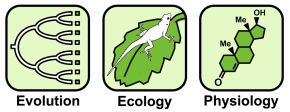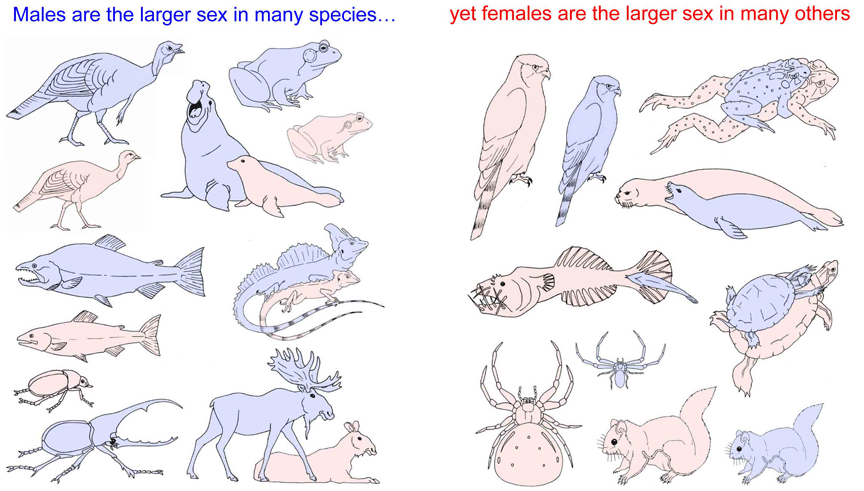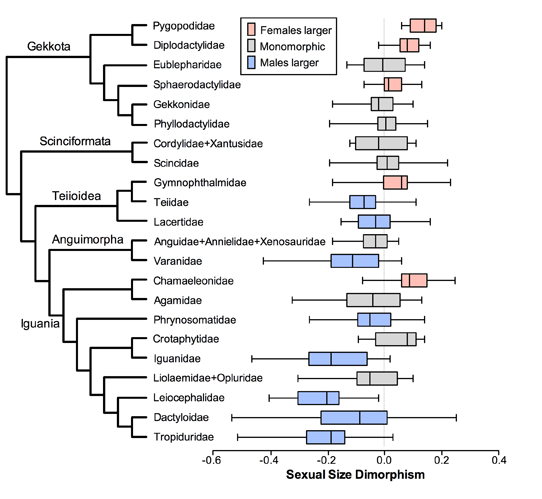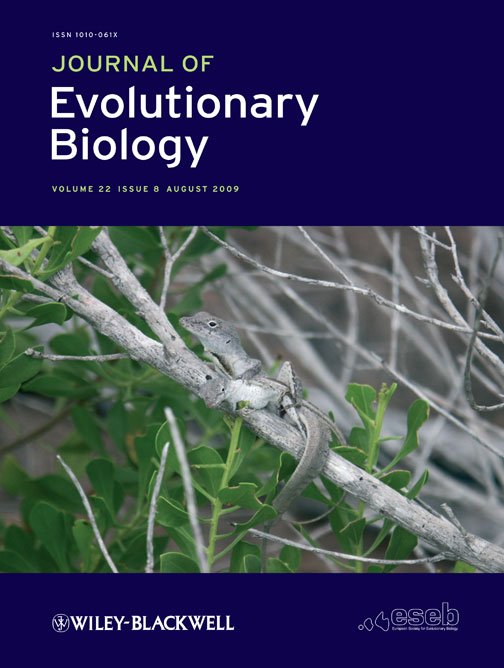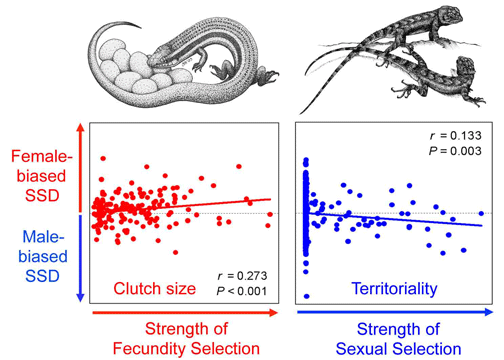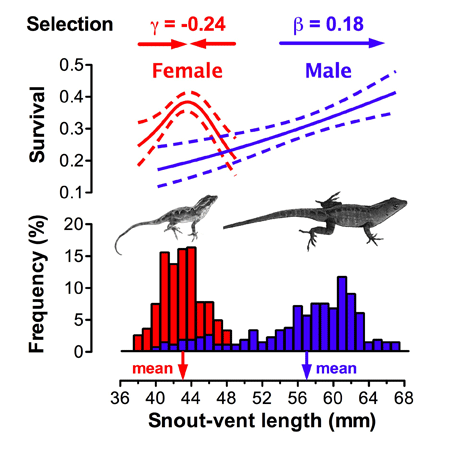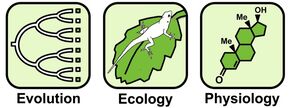Sexual size dimorphism
Much of our research on sexual conflict and dimorphism focuses on a particular type of sex difference - sexual size dimorphism. Ultimately, we want to understand why males are larger than females in some species, yet females are the larger sex in many others. This phenomenon of sexual size dimorphism is prevalent across diverse organisms.
The figure below is modified from a recent book chapter (Cox & Kahrl 2015) and shows that sexual size dimorphism is highly variable both within and among lizard families. The cover photo on the right illustrates the particularly extreme sexual size dimorphism (males are 2-3 times more massive than females) in our focal species, the brown anole.
We study the evolution of sexual size dimorphism in several ways. First, by comparing patterns of size dimorphism across species with known evolutionary relationships, we have found that evolutionary shifts traits such as territorial defense (a predictor of sexual selection for large male size) and clutch size (a predictor of fecundity selection for large female size) are associated with evolutionary shifts in sexual size dimorphism (left panel below, from Cox et al. 2003).
At the population level, we use mark-recapture estimates of survival and genetic measures of reproductive success to quantify natural and sexual selection on the body size of males and females (right panel). Mechanistically, we study how hormones such as testosterone have evolved to either promote or inhibit growth, depending upon the pattern of sexual size dimorphism exhibited by a species, and how these effects are mediated by sex-biased gene expression.
Relevant publications
Wittman, T.N., C.D. Robinson, J.W. McGlothlin and R.M. Cox. 2021. Hormonal pleiotropy structures genetic covariance. Evolution Letters.
Curlis, J.D., C.L. Cox and R.M. Cox. 2021. Sex-specific population differences in resting metabolism are associated with intraspecific variation in sexual size dimorphism of brown anoles. Physiological and Biochemical Zoology 94: 205-214.
McGlothlin, J.W., R.M. Cox, and E.D. Brodie III. 2019. Sex-specific selection and the evolution of between-sex genetic covariance. Journal of Heredity 110: 422-432.
Cox, R.M., C.L. Cox, J.W. McGlothlin, D. Card, A. Andrew, and T.A. Castoe. 2017. Hormonally mediated increases in sex-biased gene expression accompany the breakdown of between-sex genetic correlations in a sexually dimorphic lizard. The American Naturalist 189: 315-332.
Cox, C.L., A.F. Hanninen, A.M. Reedy, and R.M. Cox. 2015. Female anoles retain responsiveness to testosterone despite the evolution of androgen-mediated sexual dimorphism. Functional Ecology 29: 758-767.
Cox, R.M., and A.F. Kahrl. 2014. Sexual selection and sexual dimorphism. Chapter in: Reproductive Biology and Phylogeny of Lizards and Tuatara, edited by J. Rheubert, D. Seigel, S. Trauth and B. Jamieson. CRC Press.
Cox, R.M., and R. Calsbeek. 2010. Sex-specific selection and intraspecific variation in sexual size dimorphism. Evolution 64: 798-809.
Cox, R.M., and R. Calsbeek. 2009. Sexually antagonistic selection, sexual dimorphism and the resolution of intralocus sexual conflict. American Naturalist 173: 176-187.
Cox, R.M., D.S. Stenquist, and R. Calsbeek. 2009. Testosterone, growth and the evolution of sexual size dimorphism. Journal of Evolutionary Biology 22: 1586-98.
Cox, R.M., M.A. Butler, and H.B. John-Alder. 2007. The evolution of sexual size dimorphism in reptiles. Pp. 38-49 in Sex, Size and Gender Roles: Evolutionary Studies of Sexual Size Dimorphism. Edited by D.J. Fairbairn, T. Szekely, and W.U. Blanckenhorn. Oxford University Press.
Cox, R.M., S.L. Skelly, and H.B. John-Alder. 2003. A comparative test of adaptive hypotheses for sexual size dimorphism in lizards. Evolution 57: 1653-1669.
Wittman, T.N., C.D. Robinson, J.W. McGlothlin and R.M. Cox. 2021. Hormonal pleiotropy structures genetic covariance. Evolution Letters.
Curlis, J.D., C.L. Cox and R.M. Cox. 2021. Sex-specific population differences in resting metabolism are associated with intraspecific variation in sexual size dimorphism of brown anoles. Physiological and Biochemical Zoology 94: 205-214.
McGlothlin, J.W., R.M. Cox, and E.D. Brodie III. 2019. Sex-specific selection and the evolution of between-sex genetic covariance. Journal of Heredity 110: 422-432.
Cox, R.M., C.L. Cox, J.W. McGlothlin, D. Card, A. Andrew, and T.A. Castoe. 2017. Hormonally mediated increases in sex-biased gene expression accompany the breakdown of between-sex genetic correlations in a sexually dimorphic lizard. The American Naturalist 189: 315-332.
Cox, C.L., A.F. Hanninen, A.M. Reedy, and R.M. Cox. 2015. Female anoles retain responsiveness to testosterone despite the evolution of androgen-mediated sexual dimorphism. Functional Ecology 29: 758-767.
Cox, R.M., and A.F. Kahrl. 2014. Sexual selection and sexual dimorphism. Chapter in: Reproductive Biology and Phylogeny of Lizards and Tuatara, edited by J. Rheubert, D. Seigel, S. Trauth and B. Jamieson. CRC Press.
Cox, R.M., and R. Calsbeek. 2010. Sex-specific selection and intraspecific variation in sexual size dimorphism. Evolution 64: 798-809.
Cox, R.M., and R. Calsbeek. 2009. Sexually antagonistic selection, sexual dimorphism and the resolution of intralocus sexual conflict. American Naturalist 173: 176-187.
Cox, R.M., D.S. Stenquist, and R. Calsbeek. 2009. Testosterone, growth and the evolution of sexual size dimorphism. Journal of Evolutionary Biology 22: 1586-98.
Cox, R.M., M.A. Butler, and H.B. John-Alder. 2007. The evolution of sexual size dimorphism in reptiles. Pp. 38-49 in Sex, Size and Gender Roles: Evolutionary Studies of Sexual Size Dimorphism. Edited by D.J. Fairbairn, T. Szekely, and W.U. Blanckenhorn. Oxford University Press.
Cox, R.M., S.L. Skelly, and H.B. John-Alder. 2003. A comparative test of adaptive hypotheses for sexual size dimorphism in lizards. Evolution 57: 1653-1669.
